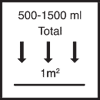Article No. 060201
Clear, hydrophobising, solvent-based impregnation on a silane/siloxane base
Product specifications
The stated values represent typical product characteristics and are not to be construed as binding product specifications.
Field of application
- Protection of facades against driving rain
- Reduces susceptibility to dirt and green discolouration
- Subsequent treatment/renewal of hydrophobic surfaces
- Subsequent impregnation of mineral paint coatings
- Porous, mineral building materials such as brick masonry work, sandstone/sand-lime brick, mineral renders and aerated concrete
Properties
- Improves resistance to frost and de-icing salts
- Highly water-repellent
- Enables water vapour diffusion
- Outstanding penetration
- UV-resistant
- Alkali-resistant
- Excellent long-term effect
- Reduces energy loss
-
Preparation
-
Substrate requirements
The substrate must be clean, dust-free and dry.
-
Preparations
Any construction defects such as cracks, cracked joints, defective connections, rising damp and hygroscopic moisture must be remedied in advance.
Perform any necessary cleaning gently, e.g. by spraying with cold or warm water or by steam-cleaning; use rotec soft whirl jet technology or Remmers cleaning products (e.g. Traffic Film Remover (0671), Clean FP (0666), Clean AC (0672), Combi WR (0675)) on tough stains.
-
-
Application
-
Application requirements
Temperature of the material, air and substrate: from min. +10 C to max. +25 °C
-
Apply the primer abundantly by flow coating without pressure (avoid misting), so that a 30 - 50 cm long liquid film flows down the surface.
Apply on one section at a time, moving from top to bottom, and immediately go over with a large brush.
Repeat the application several (at least two) times (wet on damp) until no further material is absorbed by the substrate.On surfaces where spray application is not possible, apply using a well-saturated brush.
-
Application instructions
-
Take appropriate measures to protect adjacent building elements and materials that should not come into contact with the product.
Protect freshly treated surfaces from driving rain, wind, sunlight and condensation.
Remove any excess impregnation agent within 1 hour using V 101 thinner.
During application and drying of solvent-based impregnation agents, we recommend keeping windows and doors closed.
-
-
Working tools / cleaning
-
Solvent-resistant, low-pressure conveying and spraying equipment, liquid pumps, paintbrush and flat brush
-
Tools must be clean and dry.
After use and before prolonged interruptions of work clean tools with Thinner V 101.
-
Storage / shelf life
-
If stored unopened in its original container in a cool, dry place and protected against frost, the product will keep for at least 24 months.
Use the contents of open containers as quickly as possible.
-
Usage
-
Brick masonry work, fine-pored: at least 0.8 l/m²
Brick masonry work, coarse-pored: at least 1.0 l/m²
Sand-lime brick, smooth: at least 0.5 l/m²
Sand-lime brick, cleft, bossed: at least 0.7 l/m²
Render: at least 0.5 l/m²
Aerated concrete: at least 1.0 l/m²
Fibre-reinforced cement: at least 0.3 l/m²
Modular concrete blocks: at least 1.2 l/m²
Natural stone, fine-pored: at least 0.6 l/m²
Natural stone, coarse-pored: at least 1.5 l/m² -
Apply to a large enough trial surface (1-2 m²) to determine the precise amount of impregnation agent required.
-
General information
-
Current regulations and legal requirements must be taken into account and deviations from these must be agreed separately.
The relevant test certificates must be observed when planning and carrying out work.
Water must not be allowed to penetrate behind the hydrophobized zone.
The level of absorption is crucial for the impregnation agent to work at its best. This depends on the respective pore volume and moisture content of the building material.
Carry out a quantitative analysis of aggressive salts if there are any salts present that could damage building materials.
High concentrations of harmful salts can cause major structural damage that impregnation cannot prevent.
Testing effectiveness:
The water absorption of mineral building materials can be determined using the Funcosil Test Tube developed by Professor Karsten (Funcosil Facade Testing Kit, article no. 4954).
Testing can only be carried out at the earliest 6 weeks after application.A test of effectiveness needs to be carried out on carbonaceous natural stone.
Always set up a trial area/trial areas first.
-
-
Disposal instructions
-
Larger quantities of leftover product should be disposed of in the original containers in accordance with the applicable regulations. Completely empty, clean containers should be recycled. Do not dispose of together with household waste. Do not allow to enter the sewage system. Do not empty into drains.
-
-
Safety / regulations
-
For further information on the safety aspects of transporting, storing and handling the product and on disposal and environmental matters, please see the current Safety Data Sheet.
-










